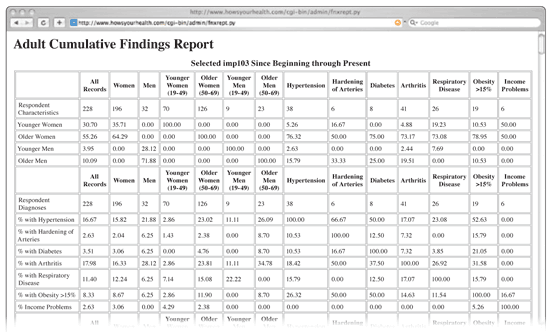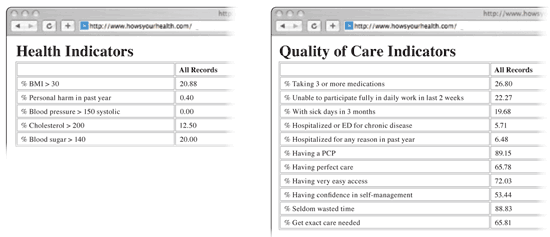
To obtain a true view of the quality of your practice, you must measure the patient's experience.
Fam Pract Manag. 2008;15(2):19-22
Dr. Guinn is a family physician in solo practice in Albuquerque, N.M. Dr. Moore is a family physician in solo practice in Rochester, N.Y. He is also a clinical associate professor of family medicine at the University of Rochester School of Medicine and Dentistry and a faculty member for the Institute for Healthcare Improvement. Both are involved in the Ideal Medical Practice (IMP) project, a national collaborative project designed to measure the outcomes of IMPs. Author disclosure: nothing to disclose. The authors would like to thank Lynn Ho, MD, and John Wasson, MD, for their contributions to this article. The work of the IMP project is supported in part by the Commonwealth Fund and the Physician's Foundation for Health Systems Excellence.

The number of initiatives designed to measure the quality of care physicians deliver continues to grow. Perhaps the only thing that's multiplying faster is the number of individual disease guidelines we juggle every time we see patients.
For the most part, the disease guidelines and the data measures are based on the best of medical evidence and expert opinion. But they are also based on the flawed idea, first taught in medical school, that patients are simply a collection of organ systems and diseases and that understanding these components will lead to an understanding of the whole person.
Consider current guidelines for hypertension, cholesterol and diabetes. (Click below to view abbreviated guidelines for each of these conditions.) Guidelines are valuable tools in the diagnosis and management of the patient's condition, but adherence to guideline elements does not necessarily define the quality of care we deliver in our practices. For example, achieving excellent diabetes metrics may identify excellence in diabetes care, but it says nothing of the rest of our care. While excellent diabetes care is laudable, the goal of primary care is excellence for all we serve. A narrowly focused assessment of our practices misses the bigger picture of how well we serve our entire patient population. Quality report cards based on insufficient numbers that peg us as champs one year and chumps the next are the unfortunate consequence of being judged on our parts and not our whole.
The philosophy of family medicine is based on the idea that the “organ and illness” model is a fallacy and should not be applied to individuals, families and communities. It's time to look at how to measure quality of care in the same light.
A new yardstick
Demonstrating quality of care in a primary care office is fundamentally different than tracking individual patient biometrics. What measures could offer insight into the “whole patient” and the quality of his or her medical care?
From the Ideal Medical Practice project as well as other research, we have identified global practice attributes that help or hinder patients.1 Access delays, lack of continuity and wasting time in the office all degrade the patient's experience of care. Degraded experience of care can become a barrier to seeking care in the future2 and has been linked to decreased outcomes.3 Measuring the patient's experience with your practice (e.g., ease of getting an appointment, connection with a primary physician and time spent waiting while at the visit) offers powerful information regarding real or perceived barriers to care, which ultimately affect quality of care.
In addition, several patient characteristics increase patients' likelihood of declining health: major problems with pain, emotional problems, financial concerns, not having the information they need to manage their conditions, and not having the confidence to use that information.1 Inquiring about each of these items and measuring patients' responses can offer valuable insight into a practice and create the opportunity to reform delivery of care in response to meaningful information. For example, increased patient confidence in self-management has been correlated with improved outcomes, including fewer sick days and less use of emergency care, as well as improved blood glucose and blood pressure measurements. This holds true even for patients who are limited by finances and social support.4 However, a measure such as “Self-management was discussed” does not get at quality of care as well as “Patient reports confidence in ability to manage his or her conditions.” The patient's experience is what ultimately matters.
HOW TO GET STARTED
Go to HowsYourHealth.org to try out the survey tool before you start using it with patients. To access the cumulative data for your practice, you'll need to sign up as a sponsor for $200 per year. You'll then receive an access code that your patients will enter when they take the survey, which will create a registry of your practice's results. To view the aggregate data for your practice, you'll click on the link “for physicians and businesses,” scroll to the end of the page, click “log-in for administration and customization,” choose “view your customizable items,” log in and then select “request summary data.” You'll see a summary of your practice that looks like the one shown here.

The report also summarizes key health indicators, such as the percentage of your patients whose blood sugar is at target, as well as quality of care indicators, such as the percentage of patients who report receiving exactly the care they need:

Patients can also print out a health summary at the end of the survey and bring it to you at their visit, or send you a copy by e-mail. The summary can help you quickly identify and understand an individual patient's issues and concerns. A sample patient summary is shown at https://www.aafp.org/fpm/20070900/27seve.html.
A tool for gathering the data
To obtain meaningful, patient-reported data, practices in the Ideal Medical Practice project are using HowsYourHealth.org, a not-for-profit tool originating from research at Dartmouth Medical School. Patients take an online survey that asks them to report their weight, blood pressure, cholesterol and blood glucose levels, if applicable; rate their physical and emotional health, bodily pain, financial resources and social support; and then answer a series of questions, such as the following:
How many prescription medications are you taking more than three days a week?
In the past year have you been in the hospital or visited an emergency room because of a chronic problem?
Do you have one person you think of as your personal doctor or nurse?
Are there things about your medical care that could be better?
How easy is it for you to get medical care when you need it?
How confident are you that you can control and manage most of your health problems?
When you visit your doctor's office, how often is it well organized, efficient and not a waste of your time?
When you think about your health care, how much do you agree or disagree with this statement: “I receive exactly what I want and need exactly when and how I want and need it.”
The online tool aggregates practice data with almost no staff effort (see the sample reports). The individual patient responses are useful in helping patients pursue healthy behavior change, and the aggregate practice data offer ample opportunities for improvement that can help with patient outcomes. This measurement approach is open to all patients in a practice, so it avoids the problem of insufficient numbers that is so common in individual insurers' attempts to measure quality of care.
At first glance, physicians may be skeptical of the How's Your Health measures, such as “I have received excellent information to manage my condition”; however, patient self-report is the ultimate assessment. What counts most isn't whether we think we've given patients the information they need but whether they've received it and can use it.
Patient-reported measures of disease-specific indicators, such as blood glucose readings, are in aggregate equal to measuring A1Cs. In one study comparing self-reported How's Your Health data to clinical markers, for 365 patients with diabetes reporting self-test results of blood sugar in the range of 80–150 “all of the time,” the average A1C was 6.8 percent. The same level of accuracy of aggregate self-reported data was evident for lipids and blood pressure readings as well.8
Of course, self-reported data is not a substitute for measuring A1C, blood pressure and all other important physiologic markers in individual patients. But there is tremendous value in measuring and understanding the patient's experience. Do they know what their physiological markers are? Do they feel confident in managing their conditions? Do they find it easy to access your practice? Do they receive exactly the care they need? These are the true measures of success in health care.
IMP SERIES OVERVIEW
This article continues our series on the “ideal medical practice” model, which is focused on high-quality, patient-centered, collaborative care; unfettered access and continuity; and extreme efficiency. The articles share learnings from practices involved in a national research project to demonstrate that the model results in high-quality care and vital and sustainable practices.
Previous articles in the series include the following: